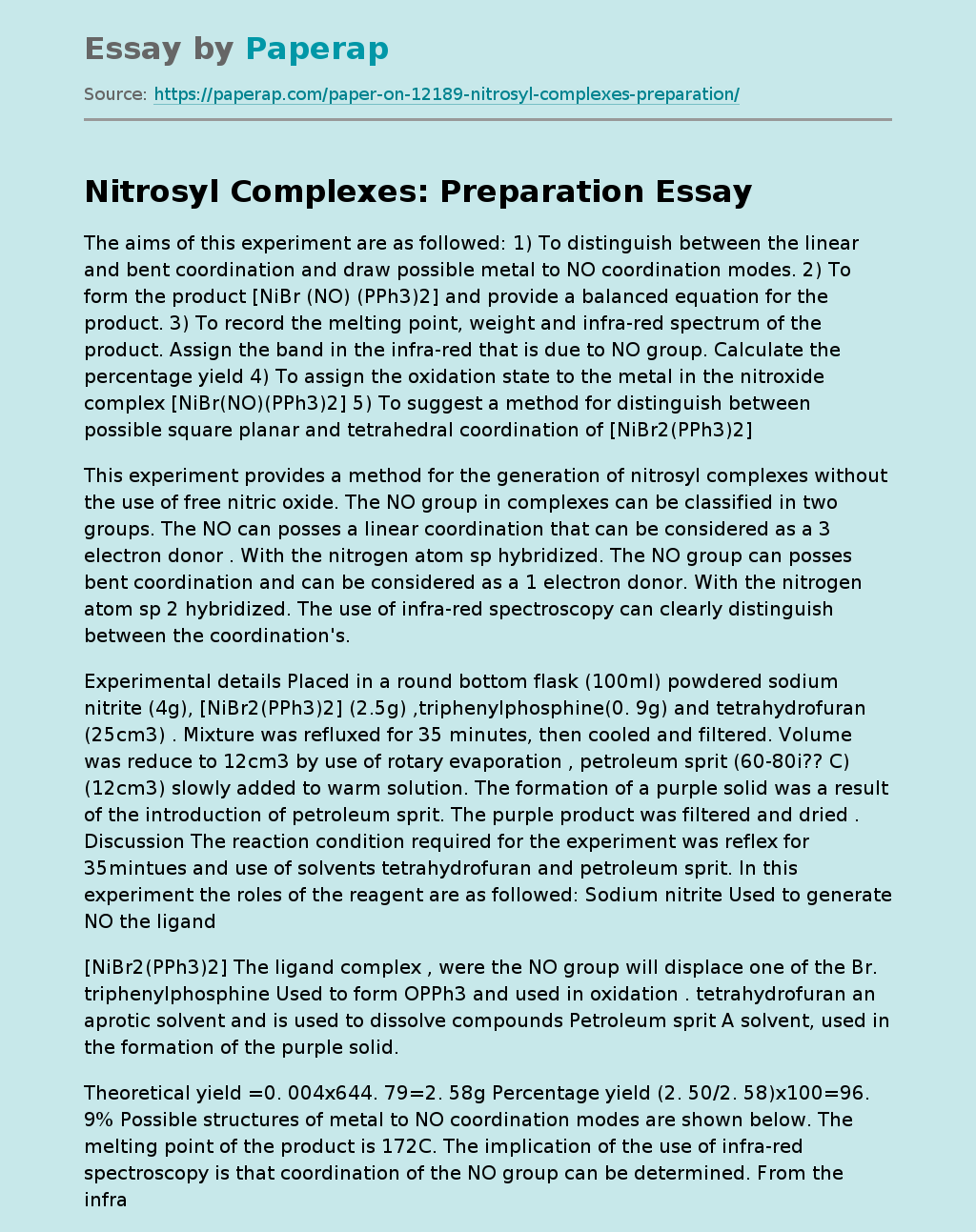The aims of this experiment are as followed: 1) To distinguish between the linear and bent coordination and draw possible metal to NO coordination modes. 2) To form the product [NiBr (NO) (PPh3)2] and provide a balanced equation for the product. 3) To record the melting point, weight and infra-red spectrum of the product. Assign the band in the infra-red that is due to NO group. Calculate the percentage yield 4) To assign the oxidation state to the metal in the nitroxide complex [NiBr(NO)(PPh3)2] 5) To suggest a method for distinguish between possible square planar and tetrahedral coordination of [NiBr2(PPh3)2]
This experiment provides a method for the generation of nitrosyl complexes without the use of free nitric oxide.
The NO group in complexes can be classified in two groups. The NO can posses a linear coordination that can be considered as a 3 electron donor . With the nitrogen atom sp hybridized. The NO group can posses bent coordination and can be considered as a 1 electron donor.
With the nitrogen atom sp 2 hybridized. The use of infra-red spectroscopy can clearly distinguish between the coordination’s.
Experimental details Placed in a round bottom flask (100ml) powdered sodium nitrite (4g), [NiBr2(PPh3)2] (2.5g) ,triphenylphosphine(0. 9g) and tetrahydrofuran (25cm3) . Mixture was refluxed for 35 minutes, then cooled and filtered. Volume was reduce to 12cm3 by use of rotary evaporation , petroleum sprit (60-80i?? C)(12cm3) slowly added to warm solution. The formation of a purple solid was a result of the introduction of petroleum sprit. The purple product was filtered and dried .
Discussion The reaction condition required for the experiment was reflex for 35mintues and use of solvents tetrahydrofuran and petroleum sprit. In this experiment the roles of the reagent are as followed: Sodium nitrite Used to generate NO the ligand
[NiBr2(PPh3)2] The ligand complex , were the NO group will displace one of the Br. triphenylphosphine Used to form OPPh3 and used in oxidation . tetrahydrofuran an aprotic solvent and is used to dissolve compounds Petroleum sprit A solvent, used in the formation of the purple solid.
Theoretical yield =0. 004×644. 79=2. 58g Percentage yield (2. 50/2. 58)x100=96. 9% Possible structures of metal to NO coordination modes are shown below. The melting point of the product is 172C. The implication of the use of infra-red spectroscopy is that coordination of the NO group can be determined. From the infra-red spectrum there is a peak at 1893 cm-1 that corresponds to the NO group. The peak falls in the range of 1650-1900cm-1. The mode of bonding of the NO can be deduce, the bonding mode is linear. The melting point also falls in the region that complements that of the linear bonding mode.
Method to distinguish between possible square planar and tetrahedral coordination of [NiBr2(PPh3)2] Using the crystal field splitting diagrams for Ni2+ in both tetrahedral and square planar. The tetrahedral field only has 2 unpaired electrons, whereas the square planar has no unpaired electrons. In the calculation of the spin only magnetic moments of each field the tetrahedral field will have 2. 83i?? B . The magnetic moment will be zero for square planar. Measure the magnetic moment of [NiBr2(PPh3)2] at room temperature. The number that is nearest to the measured magnetic moment at room temperature gives the coordination of [NiBr2(PPh3)2] .
Say the magnetic moment at room temperature is 3. 15 B for [NiBr2(PPh3)2] then the coordination is tetrahedral. The oxidation state of Ni metal is 2+. Where Br is -1,NO is -1 and PPh3 is 0. Additional learning Conclusion The experiment was a good method to determine the coordination of NO. The method allowed the aims of the experiment to be achieved. The only negative critic would be that the infra-red spectrum was that good. The peaks were not broad enough this could be due to the sample used for the infra-red not being prepared properly. A improvement would be to prepare a good sample for the infra-red.
Nitrosyl Complexes: Preparation. (2018, Jan 07). Retrieved from https://paperap.com/paper-on-12189-nitrosyl-complexes-preparation/

